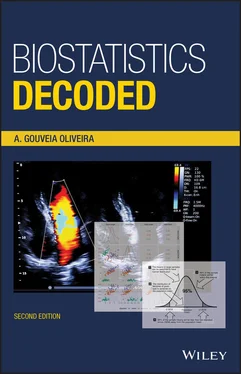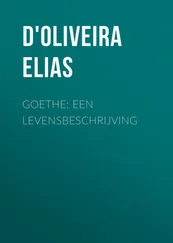7 Chapter 7Figure 7.1 Illustration of the problems of fitting a least‐squares line when...Figure 7.2 The least‐squares line fitted to the data of Figure 7.1 but with ...Figure 7.3 Transformation of the dependent variable back into proportions af...Figure 7.4 Likelihood function. The plotted values p are binomial probabilit...Figure 7.5 Illustration of the maximum likelihood estimation of regression c...Figure 7.6 Logistic regression line obtained with the method of maximum like...Figure 7.7 Results of logistic regression analysis of sex on height.Figure 7.8 Classification table of observed to predicted.Figure 7.9 The ROC curve.Figure 7.10 Development of a risk stratification system.Figure 7.11 ROC curves on the testing set and validation set.Figure 7.12 Illustration of the Hosmer–Lemeshow goodness‐of‐fit test.
8 Chapter 8Figure 8.1 Rationale and procedure of the paired t ‐test.Figure 8.2 Most commonly used non‐parametric statistical tests.Figure 8.3 Overall regression line fit over clustered observations (left) an...Figure 8.4 The logrank test is used to compare two or more Kaplan–Meier curv...Figure 8.5 Illustration of the logrank test for the comparison of Kaplan–Mei...Figure 8.6 Illustration of the adjusted logrank test.Figure 8.7 Hazard rate in women diagnosed with breast cancer.Figure 8.8 Illustration of the proportionality assumption.Figure 8.9 Visual assessment of the proportionality assumption with log–log ...Figure 8.10 Example of the result of a Cox regression.
9 Chapter 9Figure 9.1 Dataset and correlation matrix of the factor analysis example.Figure 9.2 Data points representing the value of the questionnaire items def...Figure 9.3 Factor analysis. The first factor is positioned through the cente...Figure 9.4 Factor analysis. The second factor is positioned at a right angle...Figure 9.5 Factor analysis. Eigenvalues for the five factors. The eigenvalue...Figure 9.6 Scree plot.Figure 9.7 Factor loadings of the item questionnaires on the two retained fa...Figure 9.8 Orthogonal rotation of the factors shown in Figure 9.4.Figure 9.9 Oblique rotation of the factors shown in Figure 9.4.Figure 9.10 Factor loadings after orthogonal (left) and oblique rotation (ri...Figure 9.11 Covariance matrix. The diagonal elements are shaded.Figure 9.12 Relationship of Cronbach’s alpha with the number of k uncorrelat...Figure 9.13 Item analysis.Figure 9.14 Three situations with equal correlation coefficients but differe...Figure 9.15 Illustration of the results of a test–retest study with ANOVA ta...Figure 9.16 Cohen’s kappa.Figure 9.17 Weighted kappa.Figure 9.18 Bland–Altman diagram.
10 Chapter 10Figure 10.1 Conditions for the presumption of causality.Figure 10.2 Control groups of typical experimental designs and clinical tria...Figure 10.3 Pseudo‐replicates and replicates: sacrifice replication.Figure 10.4 Simple pseudo‐replication.Figure 10.5 Randomization scheme in a completely randomized design.Figure 10.6 Effect of two different treatments A and B on the same interval ...Figure 10.7 Alternative experimental design that requires only half the numb...Figure 10.8 Procedure of a two‐way ANOVA.Figure 10.9 Two‐way ANOVA table.Figure 10.10 Comparison of results in the absence of interaction between two...Figure 10.11 Procedure of ANOVA for a full factorial design.Figure 10.12 Full factorial design for the data of an experiment with two tr...Figure 10.13 ANOVA table of the data in Figure 10.12.Figure 10.14 Multiple regression analysis of the data in Figure 10.12. These...Figure 10.15 Interaction between two treatments: the difference between leve...Figure 10.16 ANOVA model II.Figure 10.17 ANOVA table for model I and model II.Figure 10.18 Full factorial ANOVA.Figure 10.19 Components of variance of a fixed effects factorial ANOVA model...Figure 10.20 Components of variance of a random effects factorial ANOVA (mod...Figure 10.21 Components of variance of a mixed effects factorial ANOVA (mode...Figure 10.22 Steps to define the expected mean squares in a mixed model ANOV...
11 Chapter 11Figure 11.1 Schematic representation of the process of allocation of experim...Figure 11.2 Procedure of a factorial ANOVA without replication for the analy...Figure 11.3 Example of an experiment with a randomized complete block design...Figure 11.4 ANOVA table from an experiment with a randomized complete block ...Figure 11.5 Experiment with a generalized randomized block design, that is, ...Figure 11.6 ANOVA table of the data in Figure 11.5.Figure 11.7 Treatment × block interaction. The differences between treatment...Figure 11.8 Examples of balanced incomplete block designs. To the left, four...Figure 11.9 Layout of an experiment based on a factorial design with randomi...Figure 11.10 Expected mean squares (left) and ANOVA table of the model and d...Figure 11.11 Latin square. On the left, the table with which the planning of...Figure 11.12 Matrix representation of the square in Figure 11.11, on the lef...Figure 11.13 Data of the experiment with a Latin square design and ANOVA tab...Figure 11.14 Overlapping two 3 × 3 Latin squares to form a Greco‐Latin squar...Figure 11.15 Matrix representation of the square in Figure 11.14.
12 Chapter 12Figure 12.1 Value of the alpha error as a function of the number of comparis...Figure 12.2 Data for illustration of Bonferroni correction.Figure 12.3 Data for illustration of the calculation of confidence intervals...Figure 12.4 Holm–Bonferroni procedure.Figure 12.5 Table of the studentized range distribution.Figure 12.6 Studentized range distribution for k = 5 observations. The black...Figure 12.7 Procedure of Tukey’s test.Figure 12.8 Data for the calculation of Tukey’s test.Figure 12.9 Illustration of the procedure for the Student–Newman–Keuls test....Figure 12.10 Data for the exemplification of the Student–Newman–Keuls test....Figure 12.11 Statistical table of Dunnett’s test for α = 0.05.Figure 12.12 Comparison between several post hoc tests of the minimum differ...Figure 12.13 Examples of the use of contrasts.Figure 12.14 Data for exemplifying the test of a linear contrast.Figure 12.15 ANOVA from the test of a linear contrast.Figure 12.16 Examples of orthogonal contrasts and ANOVA table of the simulta...Figure 12.17 Coefficients of orthogonal contrast for three, four, and five g...Figure 12.18 ANOVA table of the test of non‐orthogonal contrasts.
13 Chapter 13Figure 13.1 Layout of a 3 × 3 × 2 factorial design.Figure 13.2 ANOVA table of the data in Figure 13.1.Figure 13.3 Interaction ARB × CCB. The differences in the means of the depen...Figure 13.4 Design matrices for 2 2and 2 3factorial designs.Figure 13.5 Initial analysis matrix for 2 2and 2 3factorial designs.Figure 13.6 Analysis matrix for the 2 3factorial design of Figure 13.5 after...Figure 13.7 Illustration of the steps in the creation of the design matrix f...Figure 13.8 Final design matrix with center points (to the left) and the lay...Figure 13.9 Results of the experiment of the example in Figure 13.8.Figure 13.10 ANOVA table of the experiment illustrated in Figure 13.9.Figure 13.11 Multiple regression of the experiment illustrated in Figure 13....Figure 13.12 Procedure for creating the design matrix for a 2 3factorial exp...Figure 13.13 Design matrix of a full 2 3factorial design and an alternative ...Figure 13.14 Procedure for creating a 2 3−1factorial design.
14 Chapter 14Figure 14.1 Scheme of a restricted randomization: for each level of factor A...Figure 14.2 Scheme of the allocation process of the experimental units to th...Figure 14.3 Layout of a split–plot design.Figure 14.4 ANOVA table of a split–plot design.Figure 14.5 Nested design.Figure 14.6 Scheme of the process of allocation of the experimental units to...Figure 14.7 Results of an experiment with a nested design, with cages nested...Figure 14.8 Determination of expected mean squares in a mixed model nested A...Figure 14.9 ANOVA table for the data in Figure 14.7.Figure 14.10 Results of an experiment with a mixed model nested design.Figure 14.11 Nested ANOVA table of the data in Figure 14.10.Figure 14.12 Results of an experiment with a model II nested design.Figure 14.13 Determination of the expected mean squares in pure model II nes...Figure 14.14 Model II nested ANOVA table of the data in Figure 14.12.
Читать дальше












